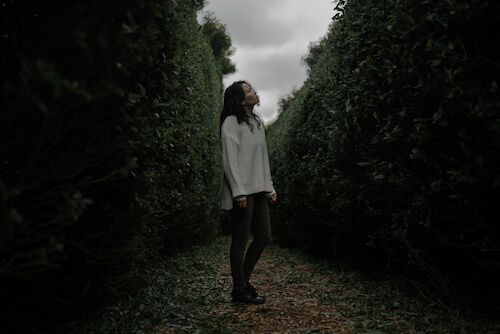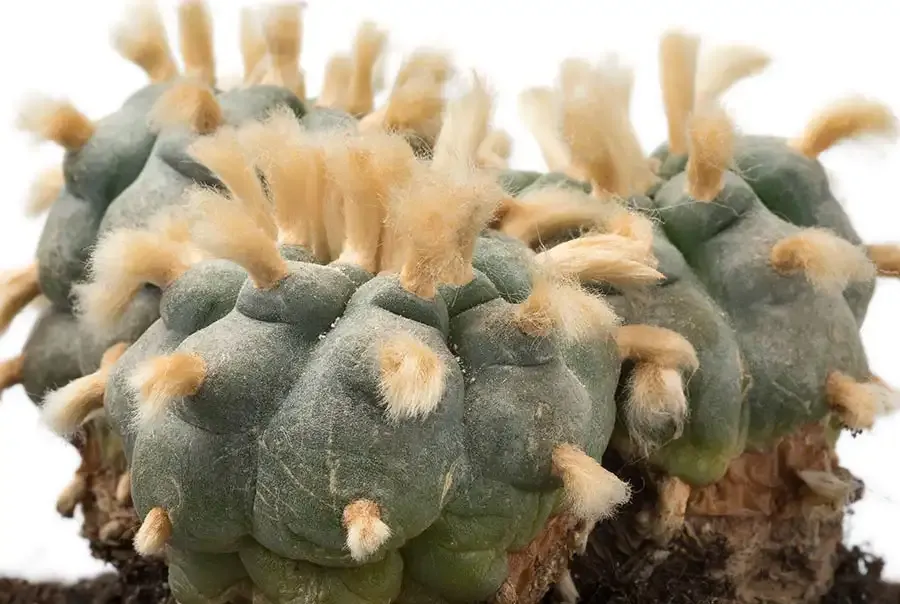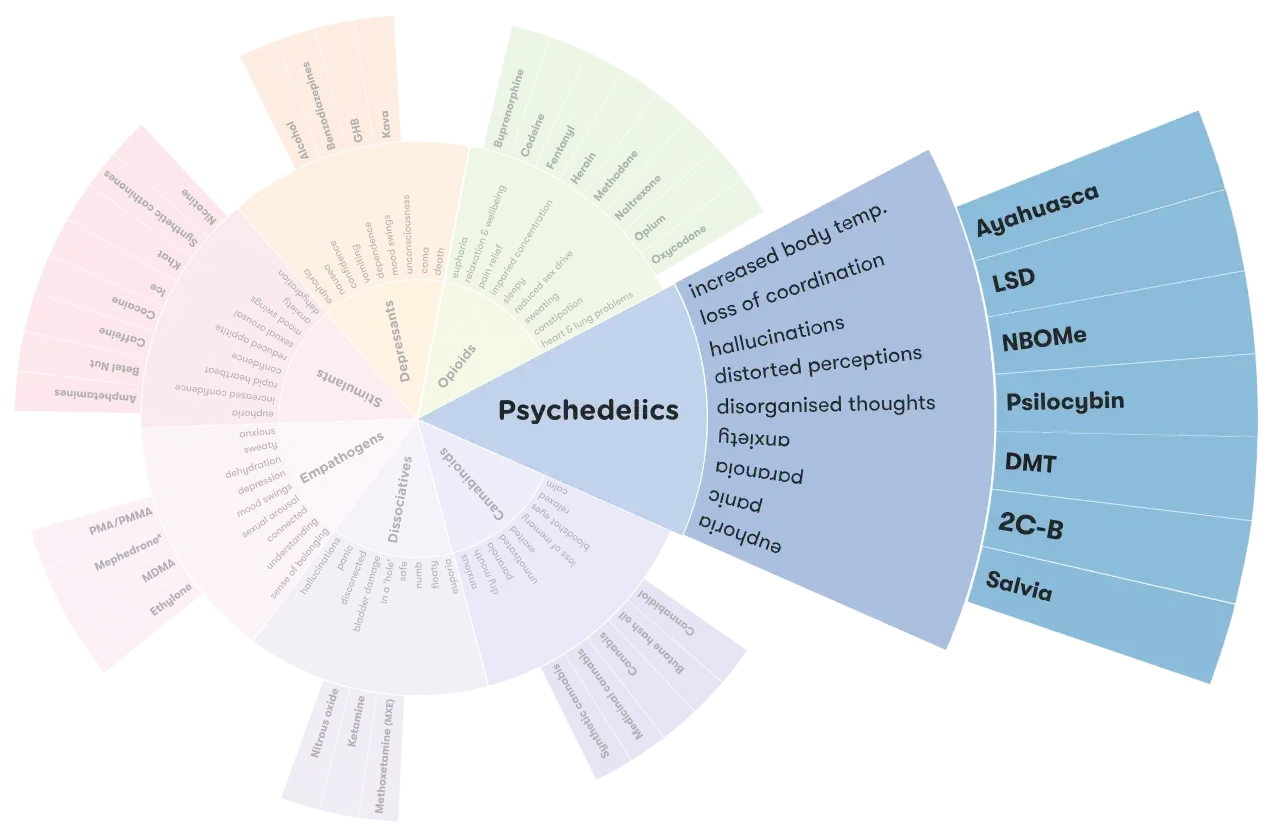What does mescaline look like?
Mescaline is a naturally occurring psychedelic that comes from the Mexican peyote cactus (Lophohora williamsii) and the San Pedro cactus found in Peru and Ecuador.2
Mescaline can be a powder, tablet, capsule or liquid. Peyote buttons can be chewed to gain the desired effects.2
How is mescaline used?
The fresh or dried buttons are chewed or soaked in water to produce a liquid. Peyote buttons can also be ground into a white powder that can be placed inside capsules to be swallowed or smoked with cannabis or tobacco. Mescaline has a bitter taste, so it is put into capsules to avoid the taste.3
Effects of mescaline
Use of any drug can have risks. It’s important to be careful when taking any type of drug.
Psychedelics affect everyone differently, based on:
- size, weight and health
- whether the person is used to taking it
- whether other drugs are taken around the same time
- the amount taken
- the strength of the drug (varies from batch to batch)
- the environment (where the drug is taken).
Mescaline affects everyone differently, but effects may include:
- euphoria
- increased energy
- perceptual distortions, such as bright lights or geometric patterns
- space and time distortion
- difficulty concentrating, thinking and maintaining attention
- increased blood pressure and heart rate
- intense nausea and vomiting
- reduced appetite
- increased body temperature and sweating.2, 4
According to anecdotal reports, the effects of mescaline take approximately 45-90 minutes to commence and can last between 9-14 hours.4
Impact of mood and environment
Drugs that affect a person’s mental state (psychoactive drugs) can also have varied effects depending on a person’s mood (often called the ‘set’) or the environment they are in (the ‘setting’).
Set is a person’s state of mind, previous encounters with psychedelic drugs, and expectations of what’s going to happen. For example, feelings of stress or anxiety before using mescaline may result in an unpleasant experience (bad trip).5
Setting is the environment in which someone consumes mescaline – whether it’s known and familiar, who they’re with, if they’re indoors or outdoors, the type of music being played and the light. For example, using mescaline in a calm, quiet and relaxed environment can lead to, or contribute to, a pleasant experience but being in a noisy, crowded place may result in a negative experience.5
Being in a good state of mind, with trusted friends and a safe environment before taking mescaline reduces the risk of having a ‘bad’ trip.
Overdose
No fatal overdoses from taking mescaline have been reported.4
Coming down
In the days after using mescaline, the following may be experienced:
- anxiety
- decreased appetite
- body and muscle aches
- insomnia
- fatigue.6
Long-term effects
Tolerance develops quickly to the effects of mescaline, therefore regular daily use rarely occurs.2 And the desire to use it can actually decrease with use.4
Mescaline and mental health
People with a family history of mental illness are more likely to experience anxiety, paranoia, delusions and psychosis after using mescaline. This is consistent with what the evidence tells us about people with mental illness and psychedelic use.7
Bad trips
Some people may have negative experiences taking psychedelics, or experiences they find challenging. This can include experiencing:
- frightening or confronting hallucinations
- intense anxiety and confusion
- fear and paranoia.2, 5
Tolerance and dependence
After use, mescaline like other psychedelics produces a tolerance period of around 3-4 days. During this period if mescaline is taken again, the effects are reduced.8
Despite the rapid development of tolerance, mescaline does not produce dependence.8
Mixing mescaline with other drugs
The effects of taking mescaline with other drugs – including over-the-counter or prescribed medications - can be predictable and dangerous.
Mescaline + cannabis = anecdotal evidence suggests combing mescaline and cannabis can cause a more intense psychedelic experience which could result in anxiety and increase the chances of having a ‘bad trip’.4
Mescaline + Tramadol® = a lowering of the seizure threshold. May cause seizures in predisposed individuals.4
Use of more than one drug or type of drug consumed at the same time, or one after the other, is called polydrug use. 9
More on Polydrug use
Polydrug use is a term for the use of more than one drug or type of drug at the same time or one after another. Polydrug use can involve both illicit drugs and legal substances, such as alcohol and medications.
Reducing harm
- Start with a lower dose until you know how the drug affects you personally. It will be different for everyone due to factors such as weight, tolerance and metabolism.
- Consider the impact of mood and environment.
- Consider having a person to 'trip sit'. A person who remains sober and can help out if needed.
- Avoid taking stimulants with mescaline as it increases blood pressure and heart rate.
- Avoid driving or operating machinery.
- Do not take mescaline if you have high blood pressure or heart problems.4
Getting help
If your use of mescaline is affecting your health, family, relationships, work, school, financial or other life situations, or you’re concerned about someone else, you can find help and support.
Call the National Alcohol and Other Drug Hotline on 1800 250 015 for free and confidential advice, information and counselling about alcohol and other drugs
Help and Support Services search
Find a service in your local area from our list. Simply add your location or postcode and filter by service type to quickly discover help near you.
If you're looking for other information or support options, send us an email at druginfo@adf.org.au
Path2Help
Not sure what you are looking for?
Try our intuitive Path2Help tool and be matched with support information and services tailored to you.

Mescaline is a schedule 9 drug and use of mescaline is against the law. Australian federal and state laws provide penalties for possessing, using, making, cultivating, selling, importing or exporting, or driving under the influence of mescaline.10
In 2022, 3% of respondents to the National Ecstasy and Related Drugs Reporting System reported using mescaline.11
- Nichols D. Psychedelics. Pharmacological Reviews 2016;68:264–355.
- Brands B, Sproule B, Marshman J. Drugs & Drug Abuse. 3rd ed. Ontario: Addiction Research Foundation; 1998.
- United States Drug Enforcement Administration. Peyote and Mescaline - Drug Fact Sheet 2020 [cited: 24.10.2022].
- Psychonaut Wiki. Mescaline 2022 [cited: 24.10.2022].
- Nutt D. Drugs without the hot air : making sense of legal and illegal drugs. Cambridge: UIT Cambridge Ltd; 2012.
- Psychonaut Wiki. Comedowns 2020 [cited: 24.10.2022].
- Krebs T, Johansen P. Psychedelics and Mental Health: A Population Study. PLoS One. 2013;8(8).
- Vedøy Uthaug M, et al. The epidemiology of mescaline use: Pattern of use, motivations for consumption, and perceived consequences, benefits, and acute and enduring subjective effects. Journal of Psychopharmacology 2022;63(3).
- Darke S, Lappin J, Farrell M. The Clinician's Guide to Illicit Drugs. United Kingdom: Silverback Publishing 2019.
- Australian Government. Federal Register of Legislation The Poisons Standard 2022.
- Sutherland R, et al. Australian Drug Trends 2022: Key Findings from the National Ecstasy and Related Drugs Reporting System (EDRS) Interviews. National Drug and Alcohol Research Centre; 2022.

